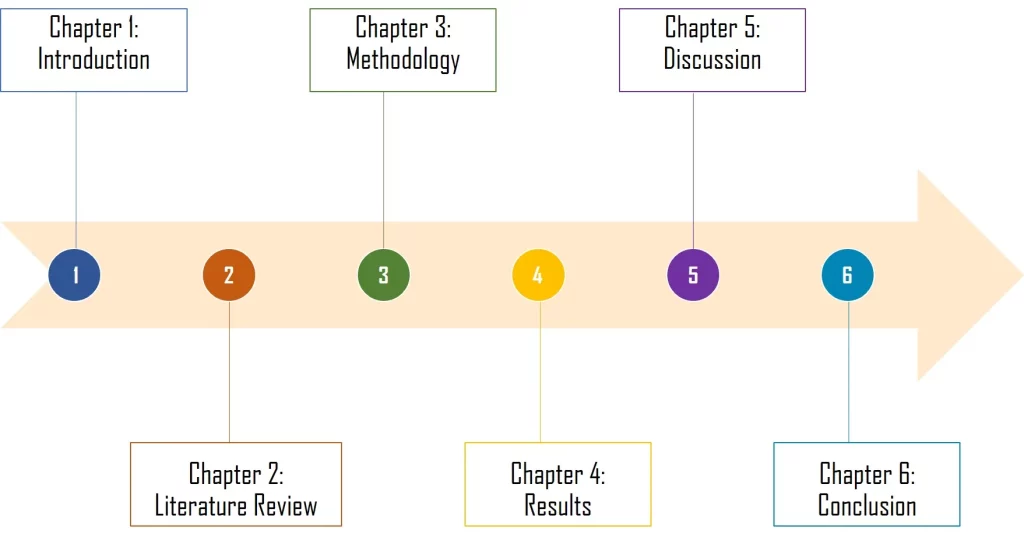
Once your thesis proposal has been approved, your focus shifts to writing your final paper. Starting to write a final thesis paper can be a daunting task, but by breaking it down into smaller steps, it is manageable. A final thesis paper is a comprehensive, in-depth research document that represents the culmination of a graduate student’s academic program. It typically includes original research or a significant contribution to the field of study and is a requirement for earning an advanced degree.
Passing in a Thesis Paper: Core Objectives to Achieve
- Demonstrate Mastery: Writing a thesis paper is an opportunity for graduate students to demonstrate their mastery of a particular subject or field of study. It allows them to showcase their understanding of the relevant literature, theory, methods, and findings in the field.
- Research Proficiency: Students must demonstrate a strong understanding of the research problem, including existing literature and current research in the chosen area/ topic.
- Contribute to the Field: A thesis paper provides an opportunity for students to contribute new knowledge and insights to their field of study. The research topic must be significant enough to warrant a study.
- Successful Defense: Graduate students are often required to defend their thesis papers in front of a committee of experts. Passing a thesis defense is testament to a student’s ability to conduct independent research, which is a highly valued skill in many professions.
Meeting these objectives is essential for the successful completion and approval of a graduate thesis paper. The key to passing in a thesis paper is preparing a well-researched, well-structured, and well-written document that effectively addresses the research question, demonstrates originality, and contributes to the field. Additionally, effective defense (if required) and adherence to institutional guidelines are crucial for success.
Steps on How to Write
- Review Your Proposal: Revisit your approved thesis proposal to refresh your understanding of your research question, objectives, and methods.
- Conduct the Study: If your study involves data collection, experiments, or other research activities, conduct the study according to the methods outlined in your proposal.
- Create a Detailed Outline:
- Organize Your Materials: Gather and organize all your research materials, data, and sources, ensuring easy access during the writing process.
- Establish a Writing Schedule: Set a regular writing schedule that aligns with your timeline and the specific deadlines for each chapter.
- Start with the Introduction:
- Next, Write the Literature Review:
- Write the Methodology Chapter:
- Write the Results Chapter:
- Write the Discussion Chapter:
- Write the Conclusion:
- Cite Sources Properly: Ensure proper citation throughout your thesis, following the citation style required by your institution (i.e. APA, MLA, Harvard, Turabian, Vancouver etc.)
- Create an Appendix:
- Write the Abstract or Executive Summary:
- Track Progress:
- Finetune the Draft:
- Finalize the Thesis Paper:
By following these steps, you can effectively write the chapters of your final thesis paper, ensuring a well-structured, well-researched, and well-written document that meets the requirements of your academic program. Remember, drafting a thesis paper is an iterative process. To pass in your thesis paper, you will need to revise the paper severally; focusing on improving the structure, argumentation, correcting errors, and incorporating feedback.
Introduction Chapter
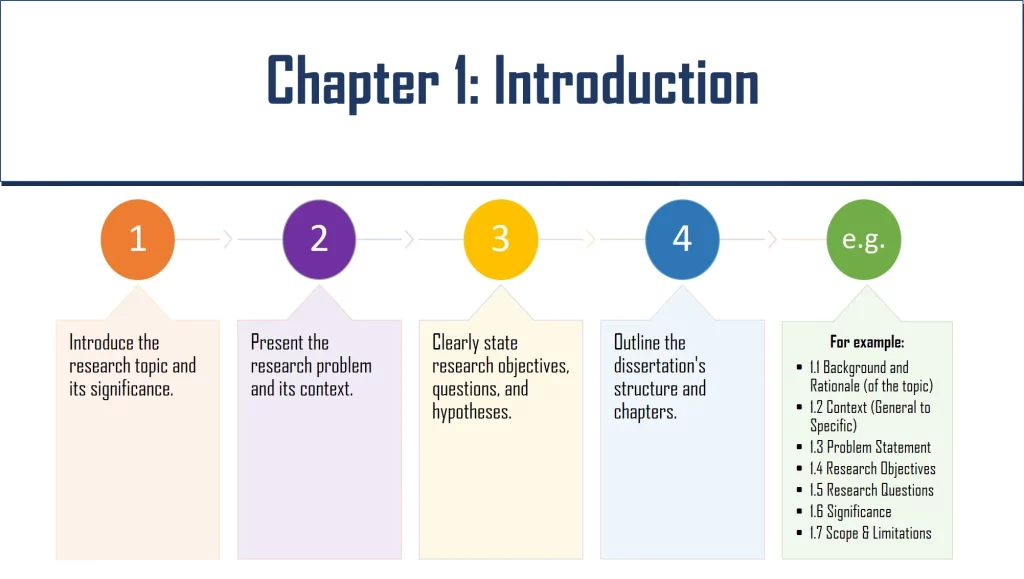
The introduction chapter in a thesis paper is the opening section that provides context for the research, presents the research problem, explains its significance, outlines the scope and limitations, sets objectives, and often includes the research question or hypotheses. It serves as the reader’s entry point into the study, offering an overview of what to expect in the thesis.
How to Write an Introduction Chapter for a Thesis Paper
Here are the key elements to include and how to write an introduction chapter for a thesis paper:
- Broad Description of Topic:
- Context (General to Specific):
- Problem Statement:
- Significance of the Problem:
- Scope and Limitations:
- Purpose & Objectives:
- Research Question:
- Hypotheses or Thesis Statement: If applicable, outline the hypotheses you plan to test in your research or provide a clear thesis statement that encapsulates the main argument of your thesis.
- Concepts: Define any key concepts, terms, or variables that are central to your study to ensure a shared understanding with the reader.
- Theoretical Framework: If your research relies on a theoretical framework or model, introduce it in the introduction chapter. Explain how the framework informs your study.
Literature Review Chapter
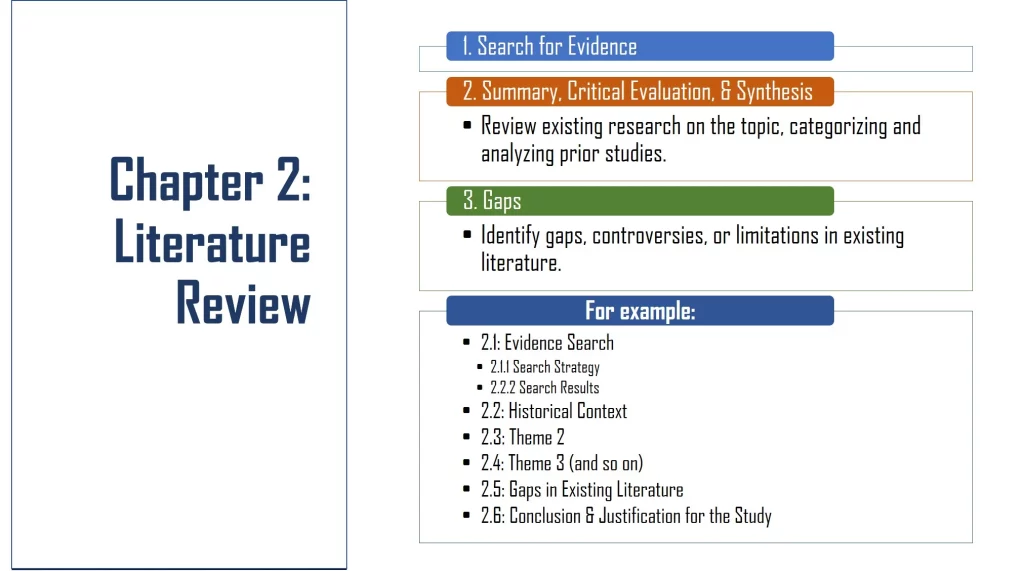
A literature review chapter in a thesis paper is a critical and comprehensive analysis of existing research and scholarly works related to the topic of the thesis. It serves several purposes:
- Contextualization: The review contextualizes the research by showing how the thesis fits into the broader academic conversation and larger body of literature on the topic.
- Survey of Existing Knowledge: It summarizes and synthesizes the current state of knowledge in the field of study, providing an overview of key theories, concepts, research findings, themes, and trends.
- Evaluating the quality of previous research: It critically evaluates the existing research on the topic, including its methodology, data analysis and conclusion.
- Identification of Gaps: It helps to identify the gap in the existing knowledge on the topic that the current research aims to fill.
- Providing a foundation for the current study: It provides a foundation for the proposed research by highlighting the key questions and issues that will be addressed.
- Theoretical Framework: It may provide the theoretical framework or models that inform the study, demonstrating the basis for the research.
- Citation of Sources: It cites and references relevant sources, allowing readers to explore those sources for more in-depth information.
The literature review is a crucial part of the thesis that demonstrates the writer’s understanding of the field, informs the research methodology, and justifies the significance of the study. It also provides a foundation for building the argument in the later chapters of the thesis.
How to Write the Literature Review Chapter for a Thesis Paper
Here are the key elements to include and how to write a literature review chapter for a thesis paper:
- Evidence Search:
- Search Strategy:
- Search Results:
- Critical Analysis and Synthesis of Evidence:
- Organization:
- Critical Evaluation:
- Synthesis of Evidence:
- Identification of Gaps:
The combination of a rigorous evidence search, critical analysis of selected sources, and identification of gaps in the existing research is essential for a strong literature review in a thesis paper. It demonstrates your ability to evaluate and synthesize scholarly work and positions your own research within the context of the current state of knowledge in your field.
Methodology Chapter
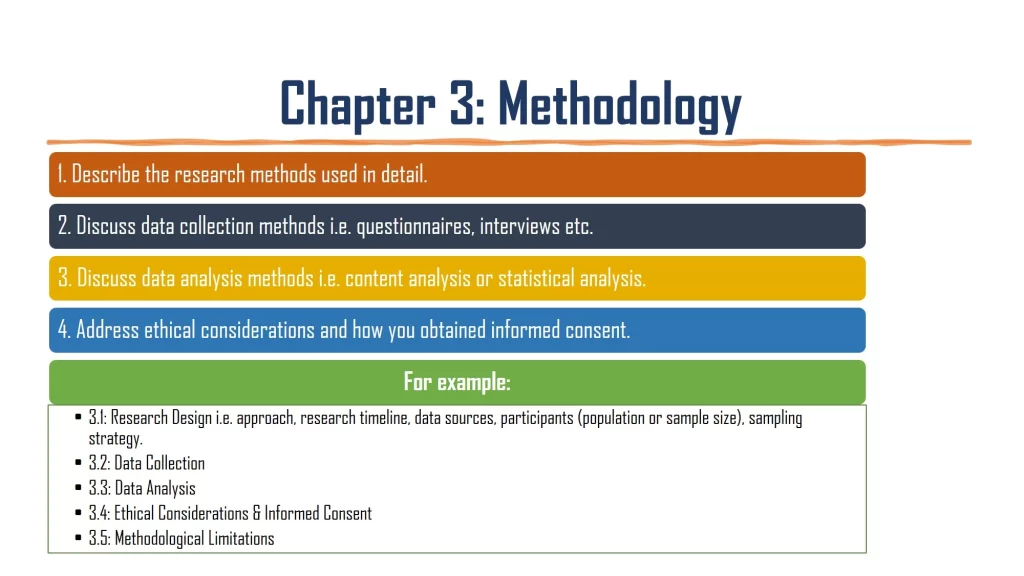
The methodology chapter in a thesis paper outlines the specific methods, techniques, and procedures that you used to conduct your research.
How to Write a Methodology Chapter for a Thesis Paper
Here are the key elements to include and how to write a methodology chapter for a thesis paper:
- Research Design: This describes the overall plan for conducting the research, including:
- Data Collection Process:
- Data Analysis Methods:
- Validity and Reliability:
- Ethical Considerations:
- Methodological Limitations:
Please note that the requirements for the methodology section may vary depending on the field and the specific research methods used. Make sure your methodology is reliable, valid and can be replicated i.e. your methodology should be able to produce consistent and accurate results and should be replicable by other researchers. In addition, remember to provide a clear link between your methodology and your research question or objective.
Results Chapter
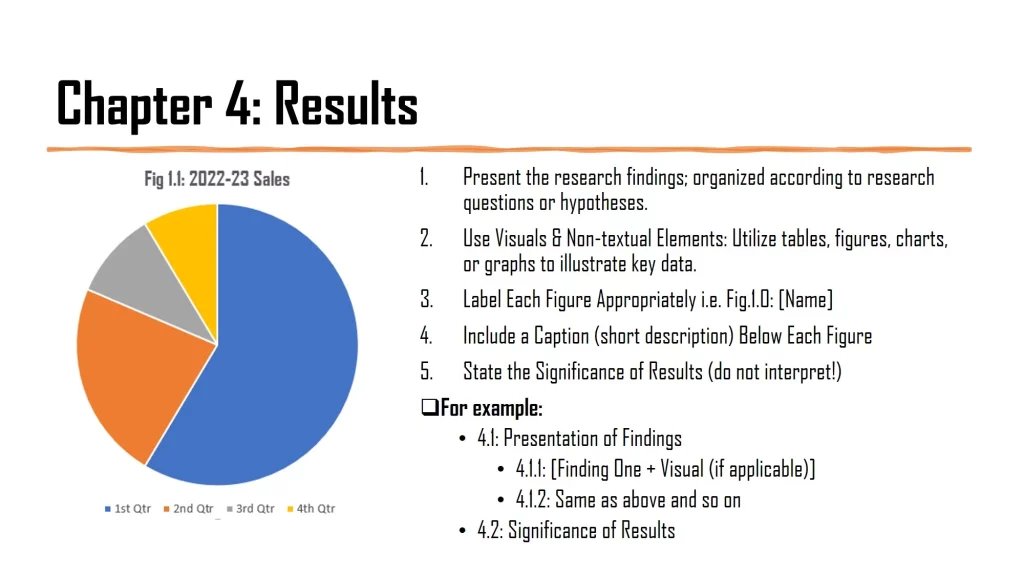
The results chapter serves to inform the reader about the outcomes of your research and lays the foundation for the subsequent discussion and conclusion chapters in your thesis paper. It should provide a transparent and objective account of the research findings, allowing readers to draw their own conclusions before you provide your interpretation and analysis in the following chapters.
How to Write a Results Chapter for a Thesis Paper
Here are the key elements to include and how to write a results chapter for a thesis paper:
- Summary of Key Findings:
- Visuals and Non-Textual Elements:
Ensure that your results are consistent with your methodology and address the gaps identified in the literature review. If there are numerous findings that need to be included, list them in the appendix section and refer to them within the body of the thesis paper i.e. “see Appendix A for complete results on the questionnaire.”
Discussion Chapter
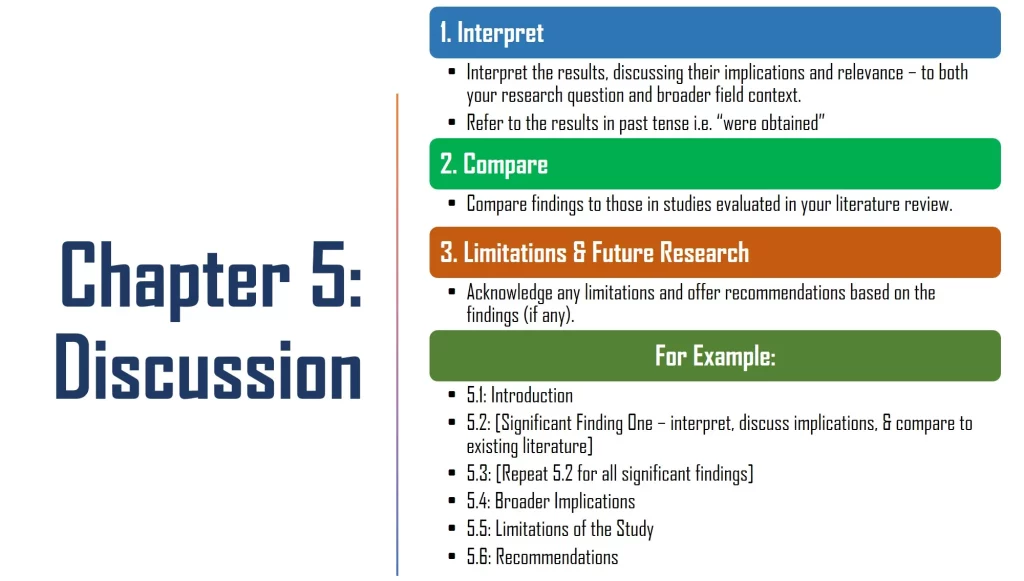
The discussion chapter in a thesis paper is where you interpret and analyze the results presented in the previous “Results” chapter. It is a critical component of your thesis paper, as it not only demonstrates your ability to understand and interpret research but also allows you to showcase the significance and contributions of your study to the field. It helps readers understand the implications of your findings and how they fit within the broader context of the subject area.
How to Write a Discussion Chapter for a Thesis Paper
Here are the key elements to include and how to write a discussion chapter for a thesis paper:
- Interpret Findings: Provide an interpretation and analysis of the results. Explain the significance of your findings in the context of your research question or problem.
- Comparison to Existing Literature: Discuss how your findings align with or differ from existing research in the field, referencing the literature you reviewed in the “Literature Review” chapter.
- Answer Research Questions or Hypotheses: Clearly state whether your research questions were answered or your hypotheses were supported by the data, and explain the implications of these findings.
- Theoretical Framework: If applicable, relate your findings to the theoretical framework or model you introduced in the “Literature Review” chapter.
- Practical Implications: Discuss the practical implications of your findings and how they might be applied in real-world contexts or specific settings.
- Address Limitations: Acknowledge and discuss any limitations or constraints in your research, explaining how they may have influenced the results.
- Future Research: Suggest directions for future research or studies that can build upon your findings or address the limitations you identified.
Note: The discussion chapter is not the place to introduce new data or results; it should focus solely on analyzing and interpreting the results already presented in the “Results” chapter.
Conclusion Chapter
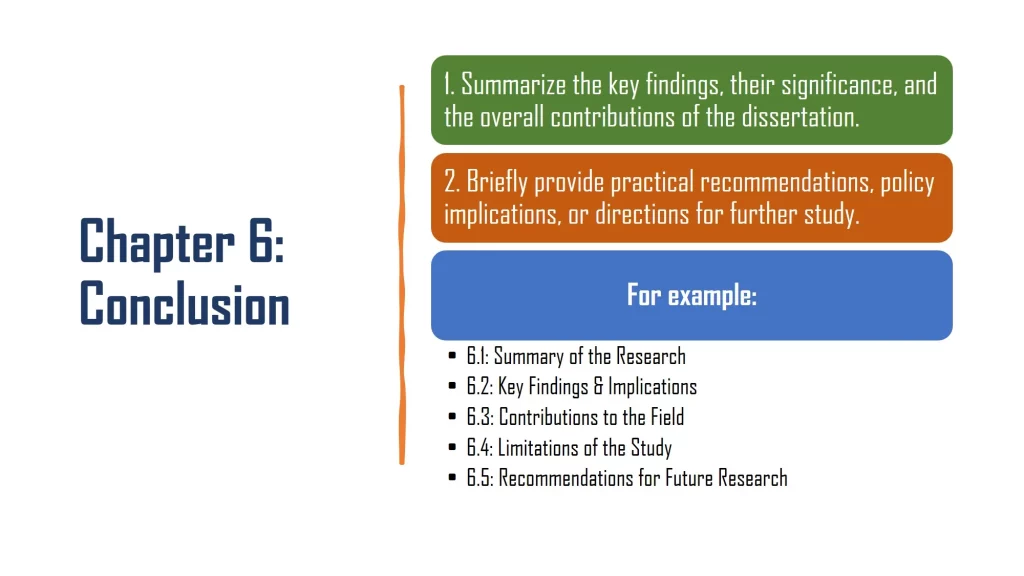
To write a conclusion chapter for a thesis paper, follow these steps:
- Summarize Key Points: Begin by summarizing the main points of your thesis, including the research question, objectives, and methodology.
- Address Research Objectives: Explain how your findings address the research objectives and research question.
- Revisit Findings: Revisit the key findings and results of your research, highlighting their significance and relevance.
- Reiterate the Significance: Reinforce the significance of your research, emphasizing its importance in the broader context.
- Reflect on the Research Process: Reflect on the research process, discussing what you’ve learned and how your perspective has evolved.
- Highlight Limitations and Future Research: Acknowledge any limitations of your study and suggest directions for future research to address these limitations.
The conclusion chapter should provide a sense of closure to your thesis and leave the reader with a clear understanding of the significance of your research. It should also inspire further thought and discussion in the field.
In conclusion, the key to writing a successful thesis paper is effective planning and organization. Develop a clear research question, create a structured outline, conduct thorough research, maintain a consistent writing schedule, seek feedback, and revise diligently. Additionally, ensure proper citation, adhere to institutional guidelines, and stay committed to producing high-quality, well-structured content that contributes to your field of study.
